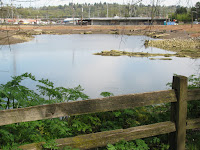


Des Moines' South 239th Street ends at a narrow set of public stairs that drop to the beach between waterfront homes and a terraced bluff. There is little sign of the original slope and the shoreline is lined with high seawalls of various histories. This is one of those old communities where I suspect the structures we see today are the 4th or 5th version of something (maybe a timber pile bulkhead) built early in the 20th century.
There isn't much beach left. Maybe it was buried beneath the walls. Maybe the last sources of sediment have long been shut off. Or maybe the beach has just continued to erode, despite the fortresses on the bluff, and 80 years has left little of the original sand and gravel beach. The sediment that used to be here has had ample time to move north and is now trapped half a mile north against the south side of the Des Moines breakwater. At least someone got a nice beach out of all of this.











